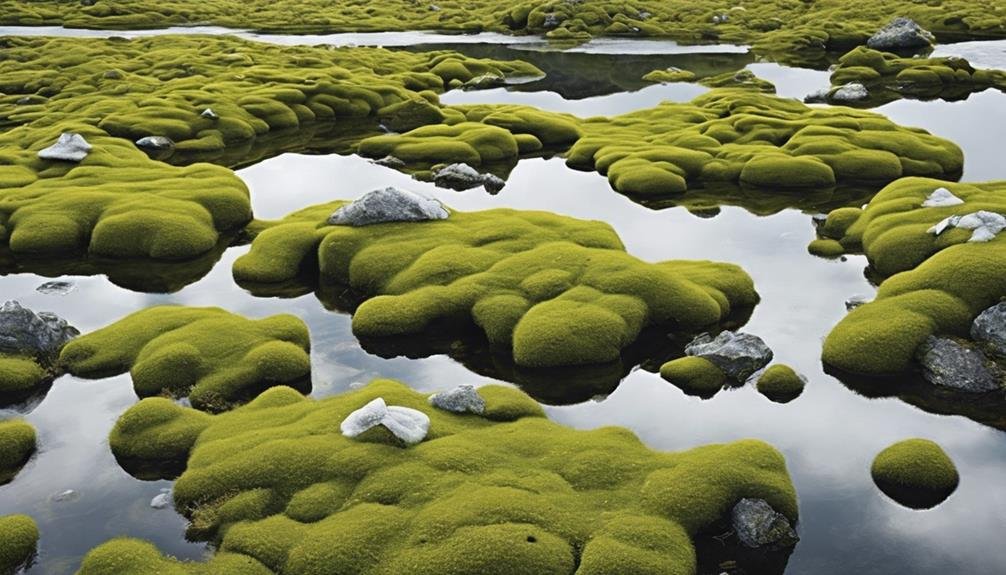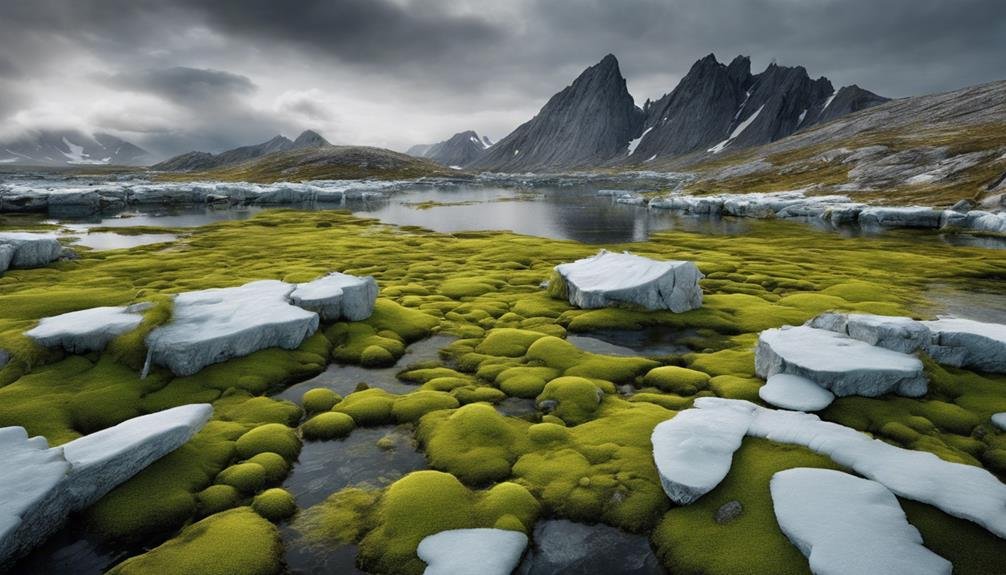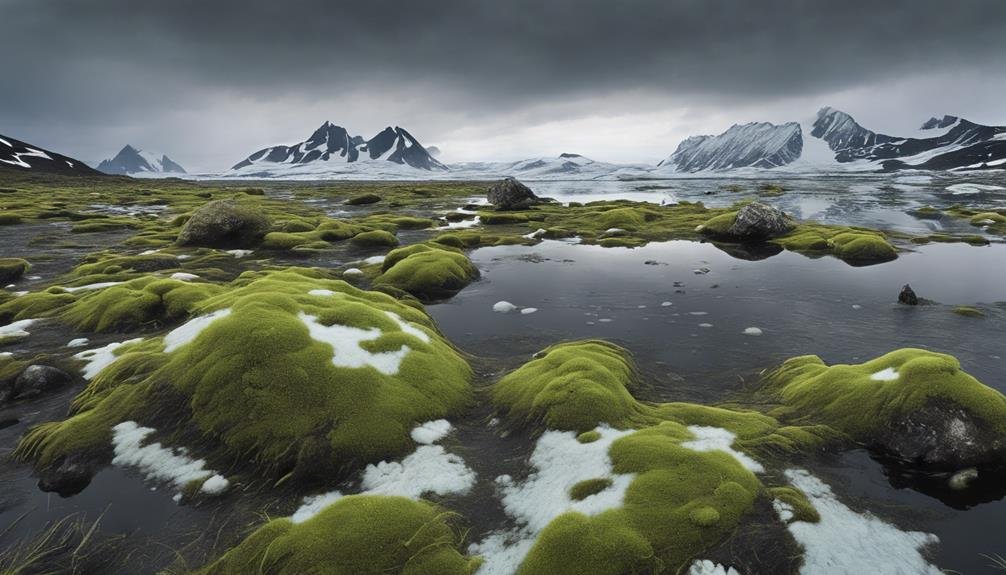Have you ever wondered how the vast, icy landscapes of the Arctic play a role in regulating our planet’s climate? At the heart of this cold region’s ecological function is the Arctic Moss, or Calliergon giganteum. This remarkable plant is not only adapted to survive in extreme conditions but also plays a crucial role in the Earth’s carbon cycle.
Arctic Moss thrives in the harsh Arctic environment, where it has developed the ability to photosynthesize with minimal light and at low temperatures. This adaptation enables it to act as an effective carbon sink, absorbing carbon dioxide from the atmosphere. Given the increasing concerns around climate change, the role of Arctic Moss in sequestering carbon dioxide is more significant than ever.
However, this vital ecological service is threatened by the warming climate, which affects the Arctic more severely than many other regions. The implications of rising temperatures and melting ice caps on Arctic Moss and its capacity to store carbon warrant urgent attention.
This overview sets the stage for a deeper investigation into the adaptations of Arctic Moss, its importance in carbon sequestration, and the challenges it faces in a warming world. The need for research and conservation efforts to protect this key species and its environment is clear, emphasizing its importance in the global fight against climate change.
Key Takeaways
Key Takeaways:
- Calliergon giganteum is highly resilient in extreme Arctic conditions, which is crucial for its survival and the functioning of its ecosystem.
- Its ability to store carbon and retain moisture supports nutrient cycling, benefiting the broader Arctic environment.
- The preservation of Calliergon giganteum is vital for maintaining ecological balance and supporting diverse Arctic life forms.
- Climate change poses a significant threat to this species, highlighting the need for conservation efforts.
Preserving Calliergon giganteum is essential for the Arctic ecosystem’s health and resilience, given its role in nutrient cycling and supporting various life forms. Addressing climate change challenges is crucial to safeguard this species and, by extension, the polar ecosystem.
Exploring Polar Flora
Arctic Moss: A Keystone of the Tundra
The Arctic tundra is home to Calliergon giganteum, commonly known as Arctic moss. This moss is vital for the ecosystem, thriving in the cold and playing a significant role in maintaining the tundra’s ecological balance. Its ability to withstand freezing temperatures, strong winds, and minimal sunlight highlights its resilience and importance to the environment.
Vital Contributions to the Ecosystem
Arctic moss significantly warms the soil, encouraging the growth of other plant species. It’s a crucial food source for migrating birds, enhancing the tundra’s biodiversity. Adaptations like nutrient storage, underwater growth, and spore reproduction allow it to thrive in seemingly uninhabitable conditions.
Conservation Efforts
Preserving Arctic moss habitats is critical for the health and stability of the Arctic ecosystem. Protection of these areas ensures the survival of Calliergon giganteum and the diverse life it supports.
Green Aquatic Plant

Adaptations to the Arctic Environment
The Arctic is a region of extreme conditions, where only the most resilient species can thrive. Arctic moss, or Calliergon giganteum, is a prime example of such resilience. This green aquatic plant has developed unique adaptations to survive. Instead of traditional roots, Arctic moss uses rhizoids to anchor itself, allowing it to absorb nutrients and water directly from its surroundings. This adaptation is particularly useful in the nutrient-poor soils of the Arctic. Moreover, its growth rate is remarkably slow, about 1 cm per year, highlighting its ability to endure the long, harsh winters and short summers of the Arctic.
Ecological Contributions
Beyond its survival capabilities, Arctic moss plays a critical role in its ecosystem. It acts as a nutrient reservoir, storing essential nutrients during the winter and releasing them in spring, which supports the growth of surrounding plant life. This moss also has a unique ability to survive underwater, which protects it from the extreme cold and makes it a reliable food source for migratory animals such as birds. By warming the ground and fostering biodiversity, Arctic moss contributes significantly to the ecological health of the Arctic tundra.
Survival and Reproduction
Reproduction is a vital aspect of Arctic moss’s life cycle. It propagates through shoots or spores, a strategy that ensures its survival in the challenging Arctic environment. This mode of reproduction allows Arctic moss to spread and maintain its presence in its habitat, despite the slow growth rate and the limited resources available. The ability to reproduce efficiently under such conditions is a testament to the incredible adaptability of Arctic moss.
Impact on Biodiversity
The presence of Arctic moss in tundra lake beds, bogs, and fens isn’t just a marvel of adaptation; it’s also essential for sustaining biodiversity in these regions. By creating a more hospitable environment for other plant species and serving as a food source for animals, Arctic moss helps maintain the ecological balance of the Arctic. Its role in the ecosystem underscores the interconnectedness of life and the importance of each species, no matter how small, in maintaining the health of our planet.
Tundra and Polar Waters
The Arctic Tundra and Its Resilient Inhabitants
The Arctic tundra and polar waters stand out as realms of extreme conditions, yet they nurture a distinctive array of life. Central to this unique ecosystem is the Arctic moss or Calliergon giganteum, a freshwater plant that flourishes despite the challenges presented by its surroundings.
The Arctic moss is a testament to resilience and adaptation. It thrives in environments where the growing season is notably short, sunlight is scarce, and nutrients are limited. Its ability to store nutrients is a vital adaptation, allowing it to spring into growth whenever the harsh conditions abate even slightly.
In the brutal climate of the tundra, where winds can howl at speeds of up to 100 mph and temperatures plummet, the Arctic moss plays a crucial role. It has the unique ability to slightly warm the ground around it, a feature that supports the growth of other plant life, fostering biodiversity and sustaining the ecosystem.
The Annual Cycle of Arctic Moss
Despite facing an environment where rainfall is meager, receiving only about 30 cm annually, Arctic moss demonstrates remarkable durability. It anchors itself with tiny rootlets and regenerates leaves every year, showcasing an impressive adaptation strategy to survive and thrive in the tundra and polar waters.
This cycle of resilience and growth not only highlights the plant’s remarkable adaptations but also underlines its importance in maintaining the ecological balance within these cold and challenging habitats.
Carbon Storage Efficiency

Thriving in Cold Climates
Arctic moss prospers in low temperatures, a trait that significantly boosts its ability to conserve nutrients and accumulate energy. This remarkable adaptation isn’t only a testament to its resilience but also amplifies its role in carbon storage, positioning it as a key player in combating climate change effects.
Prolonged Carbon Capture
Due to its slow growth rate, Arctic moss has the advantage of sequestering carbon dioxide over long periods. This process has a profound impact on atmospheric carbon levels, showcasing the moss’s significant contribution to long-term environmental sustainability.
Carbon Absorption Efficiency
The extensive layers of Arctic moss function akin to a sponge, absorbing carbon and hindering its re-release into the atmosphere. This capability is crucial for climate regulation and highlights the pivotal role of Arctic moss in the global carbon cycle.
Vulnerable to Climate Change

Arctic Moss and Climate Change Vulnerability
The Arctic moss, a key player in carbon sequestration, faces significant risks due to rising temperatures and changing precipitation patterns. These environmental shifts challenge the survival and growth of Arctic moss by disturbing their natural habitats. The balance of the Arctic ecosystem, crucial for the moss, is at risk, leading to decreased biodiversity and the arrival of invasive species that compete with the native mosses.
Human Influences on Arctic Moss
In addition to natural climate challenges, human activities like mining, oil drilling, and pollution further endanger Arctic moss. These human-induced threats compound the effects of climate change, making the conservation of Arctic moss even more pressing. Addressing both natural and anthropogenic threats is vital for the protection of these habitats.
Conservation Efforts for Arctic Moss
To safeguard Arctic moss, implementing conservation strategies to combat climate change and human impact is imperative. Efforts should focus on preventing habitat degradation and managing the threat posed by invasive species. Protecting Arctic moss is essential for its ecological significance and its contribution to the global carbon cycle.
Frequently Asked Questions
What Is the Arctic Moss?
Q: What is Arctic Moss?
A: Arctic moss is a plant that flourishes in the cold environments of the Arctic tundra. It depends on photosynthesis to obtain nutrients. The way it reproduces and its survival mechanisms are finely tuned to withstand the challenges posed by the climate, making it a vital indicator of the ecological health of its habitat.
What Animals Eat Arctic Moss?
FAQ: What Animals Depend on Arctic Moss for Nutrition?
Q: Which animals eat Arctic moss for their diet?
A: Migratory birds, reindeer, and muskoxen rely on Arctic moss as a vital part of their diet. The consumption of moss by these animals is driven by its nutritional value. Research into their feeding habits shows the importance of understanding how changing climates affect the diets of these creatures, which is crucial for the conservation of endangered species. The impact of moss collection on the diets of these animals is an area that requires more scientific research.
How Long Can Arctic Moss Live?
Q: How long can Arctic moss live?
A: Arctic moss has the capability to live for up to 9 years. This longevity is a testament to its ability to adapt to harsh climates through slow growth, diverse reproduction methods, and specialized preservation strategies. Evidence from ancient finds confirms its durable survival mechanisms.
Why Does Arctic Moss Grow Close to the Ground?
Why does Arctic moss grow close to the ground?
Arctic moss grows close to the ground to cope with the extreme Arctic conditions it faces. This adaptation strategy allows it to maximize sunlight exposure during the limited sunny periods, shield itself from harsh weather conditions like strong winds, conserve moisture in an environment where water can be scarce, and access warmth from the ground, which is relatively warmer than the air above. This unique growth pattern is crucial for its survival in a nutrient-poor and challenging habitat.
How Does Alpine Arnica Thrive in Similar Harsh Conditions as Arctic Moss?
Alpine Arnica thrives in harsh, cold climates similar to Arctic Moss by adapting to extreme altitudes and nutrient-poor soils. Its robust root system helps it secure water and nutrients, while its fuzzy leaves protect against frost. For more in-depth details, exploring alpine arnica plant info offers valuable insights into its resilience.
What Are the Differences Between Arctic Moss and Lichens in Cold Environments?
Arctic moss and lichens thrive in cold environments, but they differ in structure and adaptations. Arctic moss is a flowering plant with roots allowing water absorption, while lichens are a symbiotic partnership between fungi and algae, surviving in extreme conditions. An introduction to lichens reveals their resilience and unique biology.
Conclusion
Summarizing the significant impact of Calliergon giganteum on the Arctic ecosystem, it’s clear that this species plays a pivotal role due to its unique adaptations and contributions. Its resilience in facing harsh conditions, along with its capacity for carbon storage, are vital for nutrient cycling and moisture retention within these environments.
The challenges posed by climate change make it apparent that efforts to preserve this species are necessary. Safeguarding Calliergon giganteum is vital for preserving the balance of polar ecosystems and supporting the myriad of organisms dependent on it.


